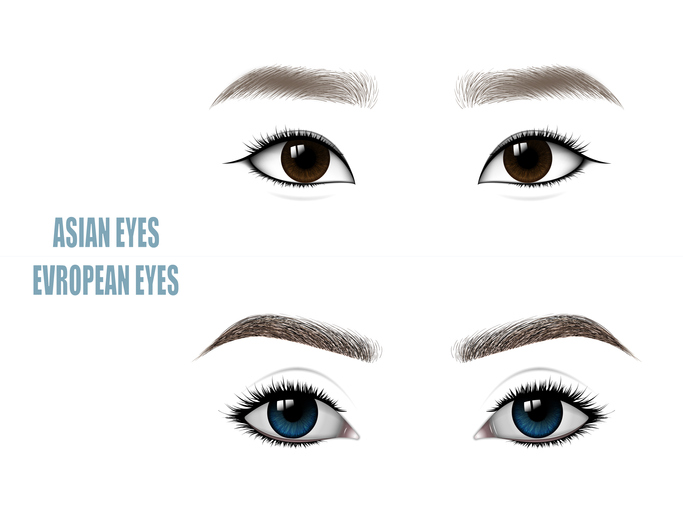The differences between the upper eyelids of Asian and Caucasian patients are threefold. The Asian eyelid is characterized by a poorly defined or absent crease, an excess of fat, and an epicanthal fold (the skin that covers the inner corner of the eye) of varying size and configuration. The goals of Asian blepharoplasty or Asian upper eyelid surgery are to create a natural-appearing upper lid crease that complements and is in balance with the other facial features, to remove excess fat, and, if necessary, to make changes to the epicanthal fold.
On the other hand, Caucasian blepharoplasty is performed to remove excess skin and fat on the eyelids in order to rejuvenate them and make them appear more youthful and energetic. Normally, the procedure is performed by making an incision along the eyelid crease to minimize the appearance of scars.
The Single Fold or Monolid
The primary difference between the upper eyelids of Caucasians and Asians is the crease above the lower margin of the upper eyelid. In many individuals of Asian descent, this crease is low-lying/poorly defined or there may be no crease at all which is referred to as a “single fold or monolid.” The lack of a crease causes the eyelashes to directly touch the top of part of the lid and give the impression of puffiness. Caucasians, however, have a clearly defined “double fold.”
Consequently, in Asian upper eyelid facial plastic surgery, one of the goals is to create this crease or supratarsal fold just above the eyelashes. The crease is considered to be more attractive for both men and women because eyelids with a crease make the eyes appear larger, more expressive, and youthful.
Removing Excess Fat and Skin
The procedure for removing excess upper eyelid skin and/or fat is similar to the procedure used to perform a Caucasian eyelid lift. However, it is performed in such a way as to maintain the characteristics of the Asian eye. The excess fat or skin is removed by making a delicate incision in the crease of the eye. Dr. Denton ensures that just the right amount of fat or skin is removed to avoid creating eyes with a hollow and sunken appearance. The fold is created during the procedure in a predetermined location with “fixation sutures”. These sutures are removed with the other skin sutures one week after the surgery. The result should be more youthful-looking eyes with more balance and symmetry and less puffiness.
Epicanthoplasty
The skin that covers the inner corner of the eye is called the epicanthal fold which can be of varying size and configuration. An epicanthoplasty is a procedure that is performed to release or partially release the epicanthal fold. The excess skin which creates a heavy epicanthal fold is therefore removed, but not all the fold is removed since it is what creates the characteristic almond shape of the Asian eye. The epicanthoplasty procedure can create softer, bigger, and more alert-looking eyes that also seem less widely spaced. Performing an epicanthoplasty can also aid in creating double eyelid folds that are smoother at the inner corner of the eye by avoiding a sharp stop or a break in the fold.
Considering Asian Blepharoplasty?
Anyone considering Asian Blepharoplasty or any other form of eyelid surgery should consult a leading board-certified Facial Plastic Surgeon, like Dr. Denton, who is highly experienced with the Asian facial anatomy and the surgical techniques required to perform it successfully.
It is important that your facial plastic surgeon takes the time to consult with you and establish a customized treatment plan. Computer imaging can also be used to reflect the anticipated changes. Dr. Denton’s philosophy is that the patient must be an equal member of the decision-making team so that he or she can make sound informed decisions and will be aware of the expected result.
To learn more about Asian Blepharoplasty or upper eyelid surgery and whether it is right for you, schedule your consultation here today. Dr. Denton can help you achieve the result that will make you feel more confident about your appearance.

